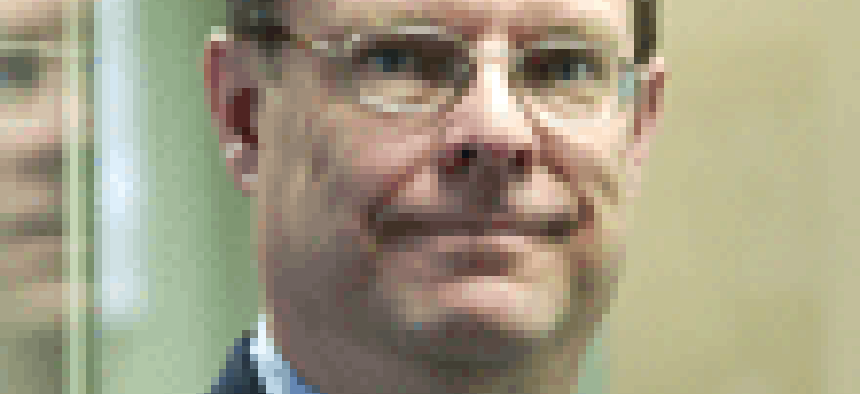Tech Success: L-3, Pyramid Vision set security in motion

The Army pitted a trained sentry against an intelligent video surveillance system several years ago in a classified test of man vs. machine.
.The Army pitted a trained sentry against an intelligent video surveillance system several years ago in a classified test of man vs. machine. Over a period of hours, a camouflaged attacker crept toward the sentry across the brush until he got within knife-throwing distance of the unsuspecting guard, who never saw the intruder coming.The video surveillance system, however, was not fooled. Its motion detection technology spotted the attacker, and had the situation been real, it would have warned the sentry that someone or something was approaching."Humans tend to dismiss bushes," said Ron Bauer, vice president of sales for Pyramid Vision, which markets the technology as VisionAlert. "Our system could detect that individual because it knew something was moving forward that shouldn't be."Today integrators use this software to help other agencies improve their video surveillance systems. In November 2003, L-3 Communications Corp. began installing VisionAlert as part of a surveillance system it was building for the Virginia Port Authority. Under a $3.4 million grant from the Transportation Security Administration, New York-based L-3 was hired to install closed-circuit TV cameras, lights and sensors that would bolster VPA's perimeter security at three major seaports: Norfolk International Terminal, Portsmouth Marine Terminal and Newport News Marine Terminal.The surveillance system includes more than 80 pan-and-tilt cameras, up from nine fixed cameras, protecting a combined 47,000 feet of fence and 25,000 feet of waterfront. Deploying the cameras to cover that vast area was one thing; actually monitoring that many video feeds to see if anyone has breached security was another. So L-3 turned to Pyramid Vision. "It's basically a force multiplier," said Rebecca Reyes, L-3's vice president of surveillance systems. By doing much of the work of human security guards, VisionAlert allows VPA to monitor a far greater area without the cost and potential lapses associated with guards."This system is better than a human because it doesn't matter if it didn't get enough sleep last night," said Bob Merhige, VPA deputy executive director. "We don't intend to have someone sit there and watch all the feeds all the time. The only time we're going to watch is when something happens."Being able to determine whether something important happens is the strength of motion detection software such as VisionAlert. Advanced algorithms must be able to sense, for example, the difference between a bird flying past the camera and a person approaching a ship.Bauer said Pyramid Vision has been developing such algorithms for years. The company is a subsidiary of Princeton, N.J.-based Sarnoff Corp., which traces its roots to RCA Laboratories, a pioneer in video technologies.VisionAlert processes every pixel of every video frame. This helps the software detect motion against a background that also might be moving, such as the water, or under severe weather conditions, such as snowstorms. It also helps stabilize images when the camera is moving unexpectedly, such as under windy conditions. The solution can be deployed quickly and costs a fraction of a comprehensive surveillance system. Reyes said the VisionAlert component was about 10 percent of VPA's bill.The software runs on a hardware appliance that accepts feeds from video sources and plugs into the central surveillance system. Each rack-mountable appliance includes two Intel Xeon server processors and handles up to four video feeds at one time.VisionAlert includes a suite of advanced security tools. Using the product's motion detection technology, colored boxes appear on VPA's monitors when a person, truck or ship enters the field of view. The software also features trigger alerts that activate when someone enters a user-defined area, loiters too long in a single location or leaves an object behind. It can also detect when people enter through an exit or drive the wrong way down a one-way street."The system also captures video, so when an alert goes off, a guard can click on a link and look at what happened," Bauer said.The VisionAlert software has been running at VPA since February and handles feeds from about half the agency's cameras. The terminals haven't suffered a security breach, but the new system came in handy when a ship leaving Newport News ran into a container crane, causing $6 million in damage."Because of the new system, we had video of the accident," Merhige said.Bauer said Pyramid Vision has seen considerable interest from agencies that want to increase security at military bases, airports, train stations and other parts of the nations' critical infrastructure. The company is at various stages of bidding on nearly 150 national and international security-related contracts, and Bauer said he expects up to 10 contracts to be awarded soon."Guards staring at a bank of monitors sometimes zone out," he said. "This system does not get bored."If you have an innovative solution that you recently installed in a government agency, contact Staff Writer Brad Grimes at bgrimes@postnewsweektech.com.
 Movement detection software watches video at Virginia ports
Movement detection software watches video at Virginia ports

"Guards staring at a bank of monitors sometimes zone out. This system does not get bored," said Ron Bauer of Pyramid Vision.
Henrik G. de Gyor
NEXT STORY: HP taps biometrics firm